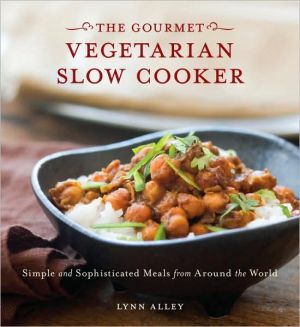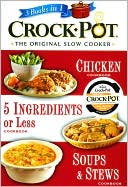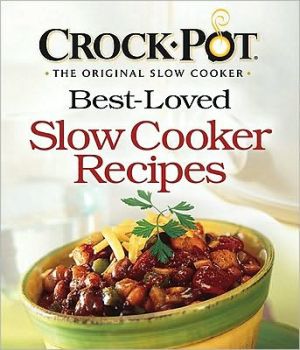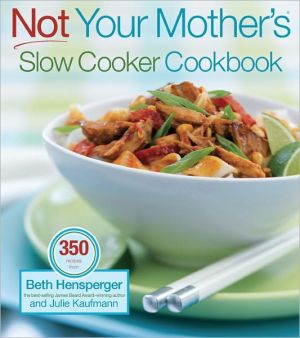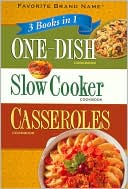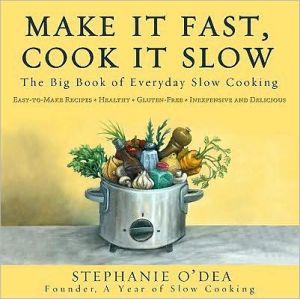Gourmet Vegetarian Slow Cooker: Simple and Sophisticated Meals from Around the World
The Gourmet Slow Cooker and The Gourmet Slow Cooker: Volume II showed home cooks everywhere that a slow cooker is perfectly capable of turning out meals that are sophisticated enough to serve to guests. It’s simply a matter of using imaginative recipes that bring together fresh, flavor-packed ingredients—and then setting the timer.\ \ In The Gourmet Vegetarian Slow Cooker, author Lynn Alley offers up more than fifty dishes, each one vegetarian, some of them vegan, and all of them...
Search in google:
The Gourmet Slow Cooker and The Gourmet Slow Cooker: Volume II showed home cooks everywhere that a slow cooker is perfectly capable of turning out meals that are sophisticated enough to serve to guests. It’s simply a matter of using imaginative recipes that bring together fresh, flavor-packed ingredients—and then setting the timer. In The Gourmet Vegetarian Slow Cooker, author Lynn Alley offers up more than fifty dishes, each one vegetarian, some of them vegan, and all of them delicious. The recipes are drawn from the world’s great cuisines and include breakfasts, soups, main courses, sides, and desserts. Dishes, such as Spiced Basmati Rice Breakfast Cereal, Smoky Potage Saint-Germain, Polenta Lasagna with Tomato-Mushroom Sauce, Soy-Braised Potatoes, and Mexican Chocolate Pudding Cake, are each paired with a beverage that is meant to complement the meal. Whether you are a vegetarian hard-pressed to find enticing recipes for your slow cooker, an omnivore looking to expand your repertoire, or a follower of a vegetable-focused diet, The Gourmet Vegetarian Slow Cooker will help you put many delightful meat-free dinners on the table with convenience and ease. Publishers Weekly Overabundant quotation marks and occasional preaching aside, the recipes in this concise collection are simple and tempting. Organized by broad cuisine categories (Indian, Mexican and Southwestern, Greek, and so on), the dishes in this book don't school readers in the finer points of different cultures' cooking styles, but they do offer easy, tasty options for meat-free comfort food: slow-cooked grits with chili and cheese; polenta gnocchi in tomato sauce; wild mushroom stew on noodles. Appealing photos showcase prepared recipes that feel a step above traditional slow cooker fare, such as rustic potato and poblano gratin; risotto with lentils; polenta lasagna with tomato mushroom sauce; and Japanese-style braised tofu. The handful of surprisingly chic desserts sprinkled throughout—including red wine and cherry risotto; Mexican chocolate pudding cake; walnut and apple bread pudding—are a sweet bonus. (Mar.)
Introduction \ \ As I wrote in the introduction to The Gourmet Slow Cooker, my first experiments with a slow cooker involved beans.\ \ I was living in a mobile home on a farm in Davis, California, for several months, and the only equipment in the old kitchen was a vintage 1970s slow cooker and a very clunky, battle-scarred frying pan. The drive in to town was more than just the hop down the road I was used to at home, so I tried to buy up at the beginning of the week and keep it really simple.\ \ The solution to the problem seemed to be beans. I went to the Davis Co-op and bought as many different kinds of beans as they had. Each day, I’d put a different kind of bean on to cook in the slow cooker. When the beans were tender, I’d add some good salt and choose an herb or two from the small herb garden outside the double-wide. A dash of olive oil gave my beans a bit of staying power.\ \ And that was how I learned to appreciate the fact that not all beans taste the same. And not all beans have the same color or texture, for that matter.\ \ This was a terrific experiment for me. It enabled me to experience something that country folk throughout the world have long known: how to take what you’ve got in the back forty and turn it into something that will keep you happy and well nourished.\ \ In Italy, such cooking has been dubbed la cucina povera, roughly translated as “the cooking of the poor,” or, more graciously, “country cooking.” It doesn’t entail using exotic and expensive ingredients from around the world. It involves the artful combining and preparing of what is at hand.\ \ Examples abound throughout this book. Think of the simple Cracked Wheat Berries with Honey and Ricotta breakfast, or the Risotto with Lentils from the Italian chapter. Or the French Alpine Cheese, Tomato, and Onion Soup which utilizes summer tomatoes, onions, bread, and cheese from France’s alpine regions. Or the Scalloped Potatoes Auvergnats, which calls for potatoes and blue cheese made in the central French region of Auvergne. Or the Baby Limas with Spinach of the Greek chapter. Or the Armenian Apricot Soup, which juxtaposes apricots from the region of their birth with the humble lentil.\ \ Although I am a food and wine writer, and have partaken of many very elegant meals prepared by professional kitchen artists and craftspeople, I admit that some of my favorite meals have been the simplest. Fried okra, just picked from a friend’s garden and piping hot on a paper towel. Warm, fresh-picked tomatoes that have never seen the inside of the refrigerator, dusted with a pinch of salt. Bread fresh from a Spanish oven with a cooling gazpacho of tomatoes, cucumbers, and onions.\ \ Those wonderful slow-cooked beans, too, remain in my heart and in my pantry. (Nowadays, I often slowcook a pot full of beans, salt them, then freeze them in individual portions so that I have something on hand either to eat unembellished or to use as a base for a soup, stew, or salad when the need arises.)\ \ It is my hope that the recipes in this book will honor the traditions of those people who have used what they had in their kitchens, pantries, and gardens in countries around the world.\ \ Some of the dishes (such as the Italian and French recipes) come from cultures where “bare bones basic” works. Some (like the Indian and Mexican recipes) come from cultures that have traditionally drawn upon a more complex mélange of ingredients and cooking techniques.\ All the dishes, however, are vegetable-based and reflective of the cultures from which they are drawn, and hence timely for the modern American kitchen, in terms of both health interests and economic considerations, in a world where many of us are realizing that we can live well and happily on a lot less than what we’ve been conditioned to believe.\ \ Most important, recipes without meat make a statement of compassion for the animals cruelly confined to factory farms throughout the world. Whether or not we consumers choose to see and acknowledge their suffering, it exists and we can choose to be a party to it or not through our food choices.\ \ \ Ingredients and Resources\ \ Beans\ \ Each type of bean has a unique texture and flavor, many of which I discovered during my first forays with a slow cooker years ago. It’s no wonder that some form of bean dish is found in nearly every culture on earth. Beans have provided protein and energy for human health, life, and growth—especially when combined with grains—for thousands of years. And beans were among the first offerings to the gods and goddesses after the harvest.\ \ The liquid left from cooking beans, when not served with them, is a bonus that can enliven soups and other dishes. Large white beans, for instance, leave lots of starch in their cooking broth, making the thick, gelatinous liquid almost perfect for thickening vegetable soups and stews.\ Slow-cooked beans taste great, and the long, slow cook often yields an almost creamy product that absorbs the flavors of herbs, spices, fats, and aromatic vegetables added to the pot.\ \ Dried beans should ideally be cooked and eaten within a year of harvest, but most of the time we as consumers have no idea about the condition of our beans. So here are a couple tips for buying beans.\ \ • Look for a store or source that has a rapid turnover of beans. They are more likely to be selling recently harvested beans than stores where the beans have been sitting on the shelf for eons.\ • The appearance of the beans can give you some clues as to how long they’ve been stored. Beans that are split, cracked, or chipped have probably been around for longer than we would like.\ \ Remember that the condition and length of storage of the beans may affect cooking times. Occasionally, I will hear a cook complain about cooking beans for as long as 14 hours, only to find skins that still remain tough and inedible. “Fresh” dried beans will always cook within a reasonable amount of time.\ \ Olive Oil\ \ Some olive oil is suitable for cooking, while some is more suitable for what chefs call “finishing” a dish. The less expensive olive oils, usually found in large quantities at a grocery store, are often suitable for cooking purposes. You can use them to brown onions or sauté vegetables. But the more expensive extra virgin olive oils are best when not subjected to the high heat of cooking, and are instead drizzled over a dish or stirred in at the last minute.\ \ Salt\ \ Most of us grew up thinking that salt is salt, but there can be great variations in flavor, texture, and even color depending on where the salt came from, how it was formed, and what’s in it. I rarely use conventional “table salt” in my cooking anymore (with the exception that I still use salt from a box for basic, large-scale cooking needs, such as soups and stews). This is because I have found that the “good” salt called for in my recipes has so much more to offer in terms of flavor and often texture than does good old Morton’s. A sprinkling of my favorite gray sea salt, for instance, is often all it takes to elevate a poached egg on toast to something very special.\ \ For this reason, you will find my recipes call for “salt to taste” rather than specific amounts of salt. If you are using conventional table salt, for instance, you should know that it is considered to be twice as potent by volume as kosher or large-grained specialty salt. So let your taste be your guide when it comes to salting your creations.\ \ Most specialty salts are large-grained and require some crushing before you can sprinkle them on your food. To this end, many stores sell special salt mills, which are like pepper mills, only designed for salt. Trouble is, many specialty salts are somewhat moist, and this moisture can gum up the works of a salt mill, even those made for specialty salts. So I have taken to grinding salt crystals by hand in a small Japanese suribachi (a sort of Japanese mortar with a ridged inner surface and wooden pestle) purchased at Sur La Table (www.surlatable.com). I have one for grinding salt and one for grinding other spices.\ \ Sea Star Sea Salt is my delicious all-purpose standby. Sea Star(www.seastarseasalt.com) is owned by chef Holly Peterson, who teaches food and wine dynamics at the Culinary Institute of America in Napa Valley. Holly sources her salt from Brittany, where it is farmed in the traditional manner. I have a handmade ceramic seashell that sits on a shelf above my kitchen stove and holds my salt stash. Next to it stands the little suribachi for grinding. It takes just a few minutes to smoosh up a batch of salt, but it makes all the difference in the world.\ \ Another “trick” I like to use is adding smoked salt for a smoky flavor to a vegetable dish that might ordinarily get its flavor from a smoked meat such as sausage, ham, or bacon. (See the Smoky Potage Saint-Germain recipe on page 79.)\ \ Playing around with and learning about this basic ingredient is a lot of fun, and although salts are not inexpensive by grocery store standards, a little bit can do a great deal to make an inexpensive meal taste like “the Ritz.”\ \ Here are a few sources where you can learn a bit and order salt:\ \ www.napastyle.com\ \ www.saltworks.us\ \ www.salttraders.com\ \ www.seastarseasalt.com\ \ www.atthemeadow.com\ \ \ Spices\ \ Although most of the herbs I use come fresh from my garden, spices (usually the seeds or bark of a plant rather than the leaves) are not so easily grown at home. My favorite source for most spices is Penzeys Spices (www.penzeys.com). I order from them online regularly. They source high-quality spices and have a large and rapid turnover offered at reasonable prices. Sit back, thumb through the online catalog, and go shopping right from your armchair!\ \ I should also note that I generally buy spices whole so that I can grind them fresh just before using. Just as freshly ground pepper is more pungent and aromatic than preground pepper that has been sitting on the shelf for who-knows-how-long, spices, too, have more to offer if they are ground just before using. In addition, grinding your own spices means that you have more control over the texture of the finished product. Sometimes I like my spices ground to a fine powder, much like how they would come out of a jar. Other times, I like them to retain some texture, especially in dishes where I want to convey a very “rustic” feel. For this reason, I have both an electric coffee grinder that is used only for spices and a couple of small Japanese suribachi that I use for crushing spices. (See further discussion and sources, page 10.)\ \ \ Useful Equipment\ \ Electric Coffee Mill\ \ An electric coffee mill that is dedicated to grinding spices is a very useful item to have on hand. Instead of buying your spices ground, you will find fresher and more interesting flavors if you buy whole spices and grind them yourself just before using. It takes only a few minutes more, but makes a great deal of difference in your cooking.\ \ Immersion Blender\ \ A handheld immersion blender looks like a long stick with a handle at one end and a tiny metal detector at the other end. It makes life with a slow cooker a breeze. Gone are the days when you have to transfer large batches of stuff by hand from the crock to a blender, blend them, then return them to the pot, leaving soup slopped all over the countertop and your clothes. You just plunge the head of the immersion blender into your beans (or whatever), turn on the blender, and purée your ingredients within minutes. It is important to keep the head of the blender under the surface of your food. If the head rises above the surface, stuff will fly everywhere—all over you and your kitchen.\ \ Mortar and Pestle\ \ I have many different sizes of mortars and pestles and have collected them for years. (The most beautiful one I have ever used was in France. It was an antique and belonged to the proprietor of a French farmhouse where I had gone to teach cooking classes. It must have weighed at least 40 pounds and was large enough to make a quart of mayonnaise in. If I thought I could have carried it home on the plane, I would have tried to buy it!) I find them most useful for grinding spices by hand, liberating flavors and aromas while retaining some interesting textures. I strongly recommend that if you really love to cook, you look around for some interesting examples and try them.\ \ \ Spiced Basmati Rice Breakfast Cereal\ \ Serves 4\ \ Most Americans would consider eating oatmeal for breakfast, but for the vast majority of Asians, rice is the breakfast food of choice. Here is a distinctively Indian variation on the Asian breakfast theme that can be cooked while you sleep and be ready for breakfast when you wake up.\ \ 11/2 cups organic brown basmati rice, rinsed well\ \ \ 31/2 cups water or soymilk\ \ 11/2 sticks cinnamon\ \ 2 green cardamom pods\ \ 1/2 teaspoon nutmeg, freshly grated if possible\ \ 1/2 cup currants or raisins\ \ 2 cups milk, heavy cream,\ rice milk, or soymilk\ \ 3 tablespoons coconut, flaked and toasted\ \ 1/2 cup walnuts or almonds, coarsely chopped and toasted\ \ Honey, for drizzling (optional)\ \ Place the rice and water in the slow cooker insert, cover, and cook on low overnight, about 8 hours.\ \ In the morning, grind the cinnamon, cardamom pods, and nutmeg to a powder in an electric coffee mill or a mortar and pestle.\ \ Add the currants and spices to the rice and stir in 15 minutes before serving. Divide the rice among 4 cereal bowls and pour 1/2 cup milk on top of each serving. Sprinkle each bowl with the toasted coconut and nuts. Drizzle with honey.\ \ Suggested Beverage: A cup of hot spiced chai would be a perfect complement.\ \ \ Curried Chickpeas with Fresh Ginger and Cilantro\ \ Serves 6 to 8\ \ As anyone familiar with Indian food knows, chickpeas are one of the most common types of legumes found on Indian tables. In this popular recipe, the spices and fresh ingredients are added at the very end of the cooking time to preserve optimum flavor and freshness. Regulate the heat by the amount of cayenne you use.\ \ 2 cups dried chickpeas\ \ 6 cups water\ \ 1 red onion, finely chopped\ \ 1/4 cup sesame or vegetable oil\ \ 1 tablespoon cumin seeds\ \ 1/4 teaspoon black peppercorns\ \ 4 whole cloves\ \ 4 green cardamom pods\ \ 11/2 teaspoons pure chile powder\ \ 11/2-inch piece fresh ginger, peeled and minced\ \ 1/2 teaspoon ground turmeric\ \ 1 teaspoon garam masala\ \ 1/2 teaspoon cayenne (optional)\ \ Salt to taste\ \ Juice of 1 lemon\ \ Yogurt, for serving (optional)\ \ 3 fresh serrano chiles, seeded, deveined, and cut into julienne, for garnish\ \ A few fresh cilantro leaves, for garnish\ \ Thoroughly rinse the chickpeas and place them in the slow cooker insert along with the water. Cover and cook on low for 6 to 8 hours, until the chickpeas are tender.\ \ In a large sauté pan, brown the onion in the sesame oil until dark brown in color, about 15 minutes.\ \ Combine the cumin seeds, peppercorns, cloves, cardamom, chile powder, ginger, turmeric, garam masala, and cayenne in an electric coffee mill or a mortar and pestle and grind to a coarse powder.\ \ Add the coarsely ground spices to the onion and continue to cook for another 5 minutes, then add the onion and spices to the cooked chickpeas. Recover and continue cooking for another 30 to 60 minutes.\ \ Using a handheld immersion blender, purée some of the chickpeas in the insert to thicken the mixture.\ \ Add salt to taste, then stir in the lemon juice. Ladle into bowls, add a dollop of yogurt, and garnish with the chile slices and cilantro leaves.\ \ Suggested Beverage: I would enjoy a light- to medium-bodied white wine, such as a Pinot Gris, Pinot Blanc, or Spanish Rueda or Albariño.
Contents Acknowledgments / 1Introduction / 3Cooking Times / 5Ingredients and Resources / 7 India / 12Mexico and the Southwest / 28Asia / 44Italy / 56France / 72Greece / 86The Middle East / 102 Index / 113
\ Publishers WeeklyOverabundant quotation marks and occasional preaching aside, the recipes in this concise collection are simple and tempting. Organized by broad cuisine categories (Indian, Mexican and Southwestern, Greek, and so on), the dishes in this book don't school readers in the finer points of different cultures' cooking styles, but they do offer easy, tasty options for meat-free comfort food: slow-cooked grits with chili and cheese; polenta gnocchi in tomato sauce; wild mushroom stew on noodles. Appealing photos showcase prepared recipes that feel a step above traditional slow cooker fare, such as rustic potato and poblano gratin; risotto with lentils; polenta lasagna with tomato mushroom sauce; and Japanese-style braised tofu. The handful of surprisingly chic desserts sprinkled throughout—including red wine and cherry risotto; Mexican chocolate pudding cake; walnut and apple bread pudding—are a sweet bonus. (Mar.)\ \ \ \ \ Library JournalAlley, author of the best-selling "Gourmet Slow Cooker" series, returns with an original collection of sophisticated vegetarian slow-cooker recipes drawn from the cuisines of Mexico, Asia, Italy, France, Greece, and the Middle East. Suggested beverages are included with most recipes, a distinctive feature for a cookbook of this type. Assuming readers already have a reliable slow cooker, Alley doesn't provide purchasing tips. Her excellent cookbook can complement such basic titles as Linda Johnson Larsen's Knack Slow Cooking: Hearty and Delicious Meals You Can Prepare Ahead, which offers advice on how slow cookers work and which size to use. For time-pressed, sophisticated cooks.\ \
